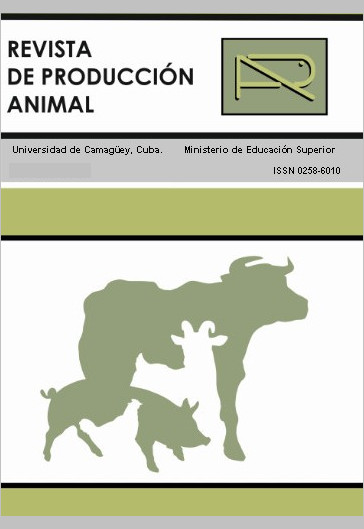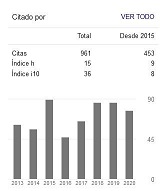Microorganismos autóctonos multipropósitos para el tratamiento de la colibacilosis neonatal porcina.
Resumen
Se evaluó la efectividad de los microorganismos autóctonos multipropósito como opción terapéutica en cerdos de la raza Yorkshire con colibacilosis neonatal. Se procesaron los datos morbilidad y mortalidad del período junio a o c-tubre de 2012, facilitados por el Centro Especializado Porcino Camujiro, de Camagüey, Cuba. El 89,8 % de los ani-males se recuperó con esta terapia.
Multipurpose Native Microorganisms to Treat Colibacillosisin Newborn Swine.
ABSTRACT
The effectiveness of native multipurpose microorganisms was assessed as a therapeutical choice in Yorkshire pigs with newborn colibacillosis. The morbidity and mortality data from the period June-October, 2012 were processed. They were kindly provided by Camujiro Swine Center, in Camagüey, Cuba. After the therapy, 89.8 % of the anim als recovered.
Descargas
Citas
AQUILINA, G.; BAMPIDIS, V.; BASTOS, M.; GUIDO, L.; FLACHOWSKY, G.; GRALAK, M. et al. (2014). Scientific Opinion on the Safety and Efficacy of Yea-Sacc® (Saccharomyces cerevisiae) as a Feed Additive for Cattle for Fattening, Goats for Fatten-ing , Dairy Cows, Dairy Sheep, Dairy Goats and Buffaloes. EFSA Journal, 12 (5), 3666-3681.
BARRETO, G. (2007). Escherichia coli, últimos 122 años (artículo de revisión). Rev. prod. anim. 19 (número especial), 55-67.
BOIRIVANTA, M. y STROBER. W. (2007). The Mechanism of Action of Probiotics. Immunology, 23, 679-692.
BUNNER C. A.; NORBY, B.; BARTLETT, P. C.; ERSKINE, R. J.; DOWNES, F. P.; KANEENE, J. B. (2007). Prevalence and Pattern of Antimicrobial Susceptibility in Escherichia coli Isolated from Pigs Reared under Antimicrobial-Free and Conventional Production Methods. J. Am. Vet. Med. Assoc., 231, (2), 275-83.
CAMPAL, A. (2009). Panel de anticuerpos monoclonales anti-fimbrias como herramienta para la detección de Escherichia coli enterotoxigénicas en porcinos. Tesis de doctorado en Ciencias Veterinarias, CENSA, La Habana, Cuba.
CORCIONIVOSCHI, N.; DRINCEANU, D.; STEF, L.; LUCA, I.; JULEAN, C. y MINGYART, O. (2010). Probiotics-Identification and Ways of Action. Innova-tive Romanian Food Biotechnology, 6, 1-11.
CORR, S. C. (2007). Bacteriocin Production as a Mechanism for the Antiinfective Activity of Lacto-bacillus salivarius UCC118. Proc. Natl. Acad. Sci., 104, 7617-7621.
COX, E. (2011). Colibacillosis in Swine. Reviewed at Lesaffre Symposium, Lille, France, November 8-9. Extraído el 15 de mayo de 2015, de http://www.colibacillosis_in_swine_reviewed_at_Lesaffre_symposium.html.
DELGADO, R. (2014). Efecto probiótico de Saccharo-myces cerevisiae en la ganancia de peso y salud de terneros en pastoreo. Tesis de maestría en Produc-ción Animal Sostenible, Facultad de Ciencias Agropecuarias, Universidad de Camagüey, Cuba.
LIÉVIN, V.; PEIFFER, I.; HUDAULT, S.; ROCHAT, F.; BRASSART, D.; NEESER, J. R. et al. (2000). Bifidobacterium Strains from Resident Infant Human Gastrointestinal Microflora Exert Antimicrobial Activity. Gut., 47, 646-652.
MACÍAS, M.; DOMÍNGUEZ, P. L.; ABELEDO, C. M.; SOSA, R.; GARCÍA, A.; CRUZ, E. et al. (2015). Manual de procedimientos tecnicos para la crianza porcina. La Habana, Cuba: EDIPORC-Instituto de Investigaciones Porcinas.
MEGANCK, V.; HOFLACK, G. y OPSOMER, G. (2014). Advances in Prevention and Therapy of Neonatal Dairy Calf Diarrhoea: a Systematical Review with Emphasis on Colostrum Management and Fluid Therapy. Acta Vet Scand., 56 (1), 75.
MORRISON, D. J.; MACKAY, W. G.; EDWARDS, C. A.; PRESTON, T.; DODSON, B.; WEAVER, L . T. (2006). Butyrate Production from Oligofructose Fermenta-tion by the Human Faecal Flora: What is the Con-tribution of Extracellular Acetate and Lactate? Br. J. Nutr., 96, 570-577.
RODRÍGUEZ, H.; BARRETO, G.; BERTOT, J. y VÁZQUEZ, R. (2013). Microorganismos eficientes como promotores del crecimiento en cerdos hasta el destete. REDVET, 14 (9). Extraído el 15 de mayo de 2015, desde http://www.veterinaria.org/revistas/redvet/n090913.html.
WINDEYER, M. C.; LESLIE, K . E.; GODDEN, S. M.; HODGINS, D. C.; LISSEMORE, K . D. y LEBLANC, S. J. (2014). Factors Associated with Morbidity, Mortality, and Growth of Dairy Heifer Calves up to 3 Months of Age. Prev Vet Med., 113, 231-240.
ZAKARIA, Z.; GAIROLA, S. y MOHD, S. (2010). Effective Microorganisms (EM) Technology for Water Quality Restoration and Potential for Sustainable Water Resources and Management. International Congress on Environmental Modelling and Software Modelling for Environment’s Sake, Fifth Biennial Meeting, Ottawa, Canadá. Extraído el 15 de mayo de 2015, desde http://www.sandrelli.net/Effective%20microorganisms.pdf.
Los autores de los artículos publicados en RPA retienen los derechos de autor de su trabajo, de marca y patente, y también sobre cualquier proceso o procedimiento descrito en el artículo, así como a compartir, copiar, distribuir, ejecutar y comunicar públicamente el artículo publicado en la RPA o cualquier parte de aquel siempre que indiquen la fuente de publicación (autores del trabajo, revista, volumen, número y fecha), pero están de acuerdo en que la revista publique los trabajos bajo una licencia Creative Commons.
![]() Licencia Attribution-NonCommercial 4.0 International (CC BY-NC 4.0)
Licencia Attribution-NonCommercial 4.0 International (CC BY-NC 4.0)






































